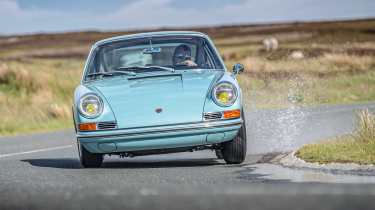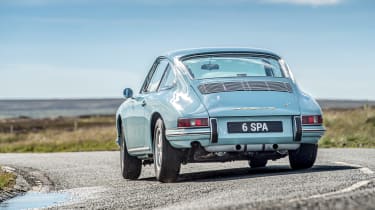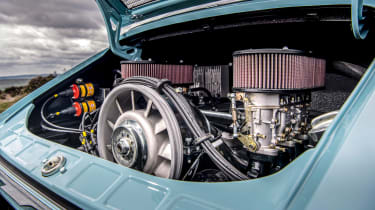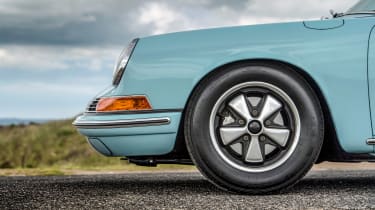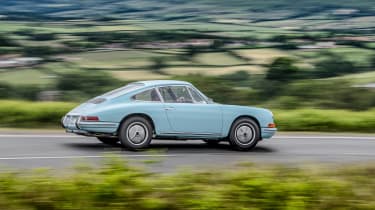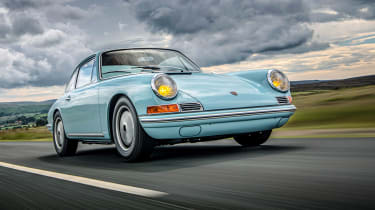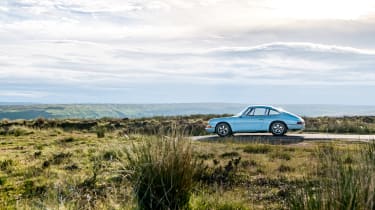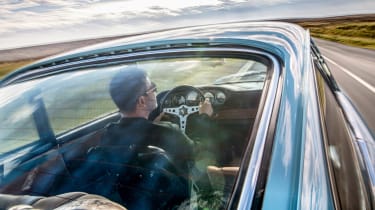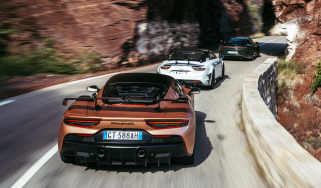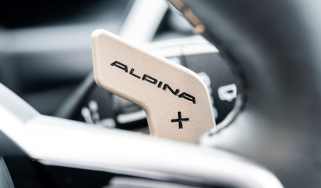Sports Purpose Porsche 911 ‘545’ review
A world away from today’s new Porsche 911s, this 1965 example from Sports Purpose is a meticulously honed vision that puts driving purity ahead of outright speed
Almost from the moment the Porsche 911 was introduced people have wanted to make them go faster. Nearly six decades on it remains a cause many enthusiasts dedicate themselves to, be they Porsche’s own Andreas Preuninger – architect of successive generations of factory GT cars – to all manner of tuners, restomodders and marque specialists who look to put their own stamp on Stuttgart’s most enduring model.
It’s a vibrant and crowded scene, with many specialists focusing tightly on a specific 911 era. Among them is Sports Purpose. Founded in the spring of 2018 by James Turner, the Oxfordshire-based concern sources and sells some of the rarest and most sought-after Porsches from its base at Bicester Heritage. Short-wheelbase 911s are a particular passion, and in parallel with starting his business, Turner also dedicated himself to developing the hugely successful 2 Litre Cup one-make race series for pre‑’66 911s. With business and race series up and running, Turner then channelled his energies (and learnings) into a project he and a friend had longed to do for many years. Namely to realise their idea of the ultimate 911 road car. The result is the car you see here.
> Ill-timed snowfall and a 150mph Porsche Cayenne autobahn run – evo Archive
More reviews
Group tests
In-depth reviews
- Porsche 911 Carrera GTS T-Hybrid review – the first hybrid 911 is one of the best
- Used Porsche 911 (991, 2011 - 2018) review – should you buy the unloved 911?
Long term tests
Reviews
To understand this car you have to understand the origins of the Sports Purpose name. And to do that you need to rewind almost 60 years to the beginning of the 911 story. For a small handful of years the 911’s competition efforts were low-key and centred upon close-to-production cars. Then, in 1967, came the 911 R, at which point everything changed.
The R was Porsche’s first full-on dedicated factory 911 race car. It was extreme and built in very small numbers – just 20 in fact – but from that point on the urge to improve, enhance and optimise the 911 for competition became Zuffenhausen’s great obsession.
In 1968 Porsche released a document entitled ‘Information Regarding Porsche Vehicles Used For Sports Purposes’, an extensive and highly detailed guide to uprating production 911 derivatives of the day (911 L, T and S) for competition use in rallying and circuit racing. Running to more than 60 pages, this legendary catalogue contained an exhaustive inventory of optional parts and upgrade packages. To Porsche fans it is akin to the Dead Sea Scrolls, or at least it would be if the Old Testament included gearing charts for the Nürburgring and an M471 lightweight bodyshell option.
The scope and flexibility of these Sports Purpose options meant customers had an almost infinitely variable combination of fully homologated upgrade kits and components with which to create 911s suited to anything from hill climbing to tackling Le Mans and the Targa Florio.
Unsurprisingly, those competition cars built during the Sports Purpose period between ’67 and ’71, such as the T/R and early S/T, possess a special mystique. Not only are they amongst the rarest 911s of all, but they served as the precursor to the more widely celebrated RS models that followed. They were the original 911 road racers.
In adopting the Sports Purpose name, Turner cleverly aligned himself with the era which best epitomises his love of Porsche. It’s the appeal and abilities of those cars he has attempted to crystallise in this, his first Sports Purpose road car project, but it also takes inspiration from other Porsche side projects of that period. Specifically the Sonderwunsch or Special Wishes programme – which began in the ’70s and gave rise to Count Rossi’s legendary road-going 917 and Mansour Ojjeh’s F1 TAG Turbo-engined 930 – and Porsche’s earlier habit of building one-off Versuch (experimental) cars for development purposes and as gifts to Porsche family members and favoured factory racers.
Inspiration was also found a little closer to home, in the work of Eagle E-types. ‘I’ve always had a huge admiration for how Eagle goes about improving E-types,’ says Turner. ‘They take classic cars that are not particularly suited to regular use in the modern world and make them into machines that work brilliantly. And all while preserving the character and magic of the original cars. Old Porsches tend to work better than old Jaguars, but that combination of careful evolution and painstaking restoration is just as relevant and appealing when applied to a 911.’
The North York Moors are a long way from Zuffenhausen, but they are the perfect place to drive Turner’s very special 911. Nicknamed ‘545’ on account of its chassis number – denoting it as the 545th 911 built – this 1965 model is a breathtakingly pretty car, one which could easily pass as a beautifully restored factory-standard car to the uninitiated enthusiast, but presents plenty of clues to its specialness if you know what you’re looking at. In this sense it’s a true connoisseur’s car: packed with performance upgrades that are both authentic and sympathetic, peppered with precious period detailing and boasting craftsmanship of the very highest level. Equally impressive is its refreshing modesty. Paradoxically this is an effortlessly cool car which required huge effort to create.
Turner’s wish was to collaborate with the best people in the business to build his ‘perfect’ 911. To this end he enlisted Richard Tuthill to oversee the powertrain and chassis development, and to put the car together. Plenty of shared dynamic DNA with the 2 Litre Cup historic race cars was a given, but far greater drivability and refinement was also a proviso for this race-bred but road-biased car. To set the highest possible level in metalwork and paint, Turner entrusted the bodyshell to Bruce Cooper at Sportwagen. Then for a unique twist, he commissioned O’Rouke Trimmers – renowned for their work on the world’s best Ferrari 250 restorations – to trade houndstooth fabric for the finest Connolly hide.
In the metal ‘545’ is absolutely gorgeous. The first shock is just how small these early 911s are. It really is pocket sized. Then there’s the pebble-smooth shape, painted to flawless perfection in a unique shade of blue, the pristine box-freshness is softened by original brightwork, which wears the gentle patina of age.
There are so many details to drink in. Chubby sidewalled road-legal Avon historic race tyres wrap a set of original Fuchs wheels, which sit just-so in the rolled wheelarches on that Tuthill-tuned suspension. Original Cibié Bi-Iode headlamps, complete with yellow Halogen bulbs, are the same lights Sports Purpose competition cars used back in the day, while the single door mirror adds some functional asymmetry. White ceramic coated exhaust pipes and the hand-painted ‘6 SPA’ registration plate complete the time-warp road racer effect.
The interior is equally glorious, the rich aroma of perfectly pleated and stitched tan hide and a beautiful full-width wooden dashboard (using timber sourced from an old building at Sports Purpose’s home at Bicester Heritage) perfectly juxtaposed by an original, careworn and extremely rare Recaro driver’s seat and equally precious period Momo Monza steering wheel. Even the gearknob is a delight. Commissioned by Turner to mimic the mushroom-shaped original, it features the Sports Purpose logo and a thin key line in the same blue as the bodywork. It’s delightfully tactile and unique to the car.
If we’d been presented with ‘545’ at Sports Purpose HQ it would have seemed almost too perfect to take away and drive, but the fact Turner has driven it up to the moors to meet us for a full day’s driving suggests this is a car that was built to be used frequently and enthusiastically.
If the detailing and aesthetic execution is a delight, the nuts and bolts are equally special. Benefitting from the latest developments used in Tuthill’s 2 Litre Cup motors (including the camshafts), the engine is enlarged to 2.2 litres for a little extra muscle without losing the wonderful free-revving nature of these small-capacity air-cooled flat-sixes. Mechanical fuel injection was considered as a period-correct tweak, but Weber carbs were fitted for simplicity and some gritty induction snort. It also runs twin-plug heads – a mod that was available in the Sports Purpose period – with the net result being 200bhp and over 160lb ft of torque delivered in a broader and more tractable band for better road manners and more accessible performance.
Chassis-wise the car employs the same springs and dampers as the 2 Litre Cup race cars, but retuned by Richard Tuthill for increased travel and compliance with no loss of control or precision. There’s also a limited-slip differential (again taken from the historic race cars) and the brakes use uprated pads, though not to race-spec.
You might be well versed in 911 driving, but if you’re new to short-wheelbase versions then a bit of adjustment will be required. The sensations are familiar, but more intense and less filtered. The rearward weight balance is more distinct, the relationship between steering and throttle inputs, and the way the car reacts to them, more symbiotic. The steering has more weight than you might expect, but there’s delicacy too. The Momo rim fidgets gently in your hands as the front wheels feel their way across cambers and surface changes, and steering effort increases as you put more loading through the car. This is a truly analogue 911, devoid of PASM, PSM or PDK, but connected, sensitive and alive at all times.
Contrary to what you might expect, you actually have to try quite hard to unstick this car. Not so hard that it requires a full send, but the tyres are grippy enough that you have to be prepared to make a deliberate sequence of inputs if you’re to get that Porsche pendulum swinging. Think of the forceful turn-in, sharp throttle lift, measured roll of opposite lock and confident re-application of throttle as the keys to unlocking a cornering experience like no other.
Get it right and the transition from grip to slip and back to grip again is seamless and almost entirely intuitive. Get it spot-on and you’ll feel the 911 work its weight distribution to perfection, outside rear wheel squeezed into the wheel housing, inside front just off the ground and turned away from the apex with a quarter turn of countersteer. Get it wrong and you’ll have a momentary leaning-back-too-far-on-your-chair moment, but even ham fists stand a good chance of gathering things up. If I had to choose one driving sensation to last me a lifetime it would be this car working just beyond its limit through a clearly sighted corner.
The engine is raspy and mechanically vocal, but nowhere near as gobby as modern high-performance cars with active exhaust valves. There’s significant induction noise when the taps are wide open, but it’s more muted at a steady cruise. In between is a fabulous range of tone and intensity that fluctuates according to rpm and throttle opening.
Smooth and happy to lug from low revs, with a free-spinning appetite for rpm, it has useful mid-range muscle and a scintillating 7500rpm top-end. Combined with gearing that’s snappy enough to make the most of the modest power and torque, but tall enough to savour the reach of the intermediate ratios, it feels brisk without having to try too hard. Better still, it really ups its game when you invest your energy into the process of hustling it along. You have to work at it to extract full performance, and the rewards are rich when you make the effort, but your enjoyment doesn’t rely solely on wringing its neck.
‘One of my fundamental beliefs about cars today is that they are just too fast,’ says Turner, echoing evo’s oft-voiced opinion. ‘Not just outright fast, but too easy to drive fast, too big because their big engines require big brakes, big tyres, big suspension. Sadly, this all too obviously applies to the 911 now. These little cars are not that quick with circa 200bhp and 1000kg, but they are so pure to drive it’s about so much more than outright speed.’
So, it won’t win you any games of Top Trumps, but if you love driving, and in particular love driving 911s, this car is a revelation. Not once during a full day’s driving on some of my favourite roads (fast roads at that) did I ever wish I was accelerating with more intensity, cornering with more commitment or travelling at higher peak speeds. The experiential emphasis is very much on emotional, physical and cerebral engagement. This is a car which you drive very much with your brain in.
Creating such a singular car doesn’t come cheap, but then the finest things rarely do. Even so, at the best part of £350,000 this is among the highest of high-end projects. ‘I know the sums involved are huge,’ concedes Turner, ‘but the simple truth is that quality always costs. The base car was £100,000. We didn’t have to buy such a solid example, but if you buy badly you can end up spending more on the rectification work than you save. Besides which, I think it makes a difference knowing you’re building from the soundest possible basis. The engine alone is £90,000, but it’s an absolute gem of a thing. We went to the best in the business for the paintwork and the same with the full interior trim. Each of these elements cost a further £30,000. Then there’s the £20,000 or so we spent acquiring really hard to find original parts such as the steering wheel, driver’s seat, brightwork, badges, mirrors and headlights. Oh, and there’s the small matter of 1000 hours’ labour to build it, plus all the time and effort it took to manage the project. You can always do cheaper, but that’s not the point with this car. I wanted it to be the best it could possibly be.’
This is not a car with which Sports Purpose intend or aspire to lock horns with Singer, whose reimagined 911s have come to define the restomod scene, and are now poised to transcend it with the $1.8million DLS. ‘545’ simply isn’t that kind of car, but it’s so good there’s no way other 911 fanatics won’t want to have one like it.
‘To build this kind of car takes so much time and effort it really is a labour of love,’ says Turner. ‘You invest so much of yourself into the process it simply doesn’t work in a scaleable commercial sense. We could handle the build of one or two cars per year, but doing so would depend on finding clients who will really dial into working with us, our suppliers and craftsmen. But, of course, there’s no such thing as perfect, so the next one could be even better…’
Sports Purpose 911 ‘545’
| Engine | Flat-six, 2.2 litres |
| Power | c200bhp |
| Torque | c160lb ft |
| Weight | c1000kg |
| Power-to-weight | c200bhp/ton |
| 0-60mph | n/a |
| Top speed | n/a |
| Basic price | c£350,000 |
This story was first featured in evo issue 290. To purchase any back issues, or subscribe visit our online shop here
